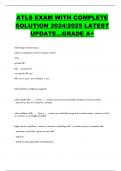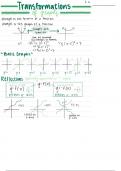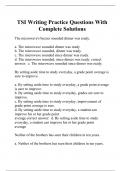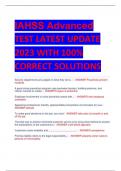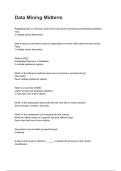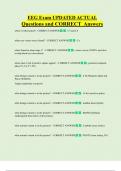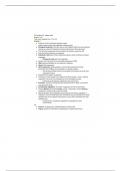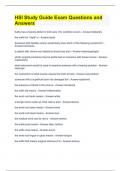Grant, A., Fried, Y. & Juillerat, T. (2011)
Micromanagement – when a manager closely observes and/or controls the work of his/her
subordinates or employees. Shows a lack of freedom in the workplace.
Classic job design definition – the set of opportunities and constraints structured into assigned tasks
and responsibilities that affect how an employee accomplishes and experiences work.
Modern job design definition – encapsulating the processes and outcomes of how work is structured,
organized, experienced, and enacted.
Job design is an actionable feature of organizational contexts. Managers typically have more influence
and control over job design than they do over culture, structure, relationships, technology, and people
themselves. Job design is an organization’s most valuable and scarce resource: the time and attention
of managers. It can be a liability or a potential source of competitive advantage for organizations.
As organizations flatten, employees have opportunities to craft their jobs, expand their roles, revise
their tasks, and negotiate new roles and idiosyncratic deals.
Where have we been? A selective history of job design research from past to present
Economic Theories of Division of Labor
Productivity could be increased if jobs were broken down into simple tasks. Simplification would
allow employees to develop specialized skills and efficient techniques. Also ‘scientific management’.
Human Relations Movement
Focusses on well-being, satisfaction, and motivation of employees. Hawthorne studies.
McGregor (1960): two theories that leaders and managers can hold:
• Theory X – leaders believe that employees are inherently lazy. Leaders micromanage
employees, restricting their autonomy and freedom;
• Theory Y – work can be as naturally enjoyable as play or rest, and doing a good job can be a
source of satisfaction in and of itself. Leaders believe that if employees are given freedom,
they will be self-motivated and ambitious, seek responsibility, exercise self-control and self-
direction, and pursue goals that benefit themselves and the organization.
Motivation-hygiene theory (Herzberg and colleagues, 1967) – satisfaction is caused by ‘motivators’
intrinsic to the nature and content of a job: opportunities to achieve, receive recognition, perform
interesting work, be responsible, grow, and advance. Dissatisfaction arises not from the job itself but
rather from ‘hygiene’ factors related to the context of the job: policy and administration, supervision,
interpersonal relations, working conditions, salary, status and security.
Job Design and Enrichment
Turner and Lawrence (1965) sought to develop a more systematic classification of the task attributes
that influence employees’ attitudes and behaviours. Jobs can be described from behavioural (what
behaviours need to be enacted for the work to be completed), technical (physical and mechanical
operations to be performed), organizational (function of the job in combining with other jobs to
achieve the organization’s goals), social (the social desirability and status of the work), and personal
(expected career progression) perspectives. They found that cultural backgrounds may shape
employees’ task preferences.
Job Characteristics Model
Hackman & Oldham (1975). The JCM focuses on five core job characteristics:
• Task significance – the extent to which the job provides opportunities to have a positive
impact on the well-being of other people;
• Task identity – the extent to which the job allows individuals to complete a whole,
identifiable, visible piece of work from start to finish;
• Skill variety – the extent to which the job involves a wide range of capabilities and talents;
• Autonomy – the extent to which the job provides freedom and discretion in how and when to
do the work;
, • Feedback – the extent to which the job itself provides clear, direct information about
performance effectiveness.
The five job characteristics lead to three critical psychological states: experienced meaningfulness,
responsibility, and knowledge of results.
The motivating potential of a job was defined as the product of (a) autonomy, (b) job feedback, and
(c) the average of task significance, task identity, and skill variety (the meaningfulness-related
dimensions), such that the motivating potential of a job = autonomy x job feedback x 1/3 (task
significance + task identity + skill variety).
Meta-analyses have revealed stronger relationships of job characteristics with psychological-attitudinal
outcomes than with behaviour and performance outcomes.
Social Information Processing Perspective
Salancik & Pfeffer (1978) – employees’ job perceptions and attitudes derive not from objective
structural properties of the work itself, but rather rom how the work is socially constructed by cues
from co-workers, supervisors, customers, family members, and other sources as well as by their own
past behaviours and experiences. Social cues can affect employees’ job perceptions and attitudes
through four different pathways:
• Direct pathway – social cues can serve as a form of social influence;
• Attentional pathway – social cues can make particular aspects of a job salient, shaping the
dimensions of which employees assess their perceptions and attitudes;
• Interpretation pathway – social cues can provide frames for assessing ambiguous job
properties, shaping the interpretations that employees make of their jobs;
• Learning pathway – social cues can provide information about what needs or values are
important, shaping employees’ judgements about what they want in a job.
Research has provided mixed support.
Sociotechnical Systems Theory
Rousseau, 1977. Individual and organizational effectiveness depend on the joint optimization of
human and mechanical-technological components of organizations. Creating autonomous workgroups
can help to accomplish such optimization.
Interdisciplinary Models of Job Design
Campion and colleagues (1988), four different approaches to job design:
• Motivational perspective – emphasizes JCM principles. Offers benefits of motivation,
satisfaction, and retention, but often involves enhanced training costs and stress.
• Mechanistic perspective – emphasizes economic and scientific management principles.
Offers benefits for efficiency and staffing and training, but tends to produce lower levels of
motivation and satisfaction.
• Perceptual-motor perspective – reducing information processing requirements. Offers the
benefits of reducing errors, accidents, and mental overload but tends to result in boredom and
decreased motivation and satisfaction.
• Biological perspective – principles of physical comfort. Offers benefits for health, stress, and
fatigue, but it tends to involve considerable financial resources and low level of physical
activity.
Second approach to job redesign: instead of enlarging them by adding more low-level tasks, they
enriched them by adding higher-level responsibilities for understanding procedures and rules for the
organization’s products. Employees may achieve greater benefits from job enrichment than job
enlargement.
Morgeson and Campion found support for the hypothesis that trade-offs between motivational and
mechanistic approaches can be avoided by enhancing specialization in task clusters.
Job Demands-Control-Support and Job Demands-Resources Models
Karasek and colleagues (1979). Providing greater job control to employees could buffer against the
detrimental effects of job demands. The job demands-resources model focuses on independent effects
of job demands and resources on different aspects of burnout. Job demands (characteristics that
require effort) are proposed to contribute to the emotional exhaustion dimension of burnout. Job
,resources (characteristics that facilitate goal achievement, demand reduction, or personal growth)
reduce disengagement or depersonalization.
Where are we now? Contemporary perspectives on job design
New Job Characteristics: Including the Physical, Knowledge, and Social
Morgeson and colleagues have developed an integrative typology and Work Design Questionnaire that
divides job characteristics into four broad categories:
• Task characteristics – focus on the five JCM characteristics of autonomy, variety, task
significance, task identity, and job feedback.
• Physical characteristics – refer to both the physical features of tasks as well as the broader
physical environments in which employees perform their tasks. Researchers have developed
questionnaires to capture the physical context of job design, which includes dimensions such
as ergonomics, physical demands, work conditions, and equipment use, and environmental
design, facilities, workload and activity levels, equipment and tools, and health and safety.
• Knowledge characteristics – jobs vary in terms of the knowledge that they require employees
to acquire, retain, and utilize. Morgeson and Humphrey (2006) synthesized research on five
knowledge characteristics of jobs:
- Complexity: describes the difficulty versus simplicity of a job;
- Information processing: captures the extent to which a job requires employees to pay
attention to events, monitor data, and actively use cognitive abilities for sense-making and
decision-making purposes;
- Problem solving: focuses on the degree to which the job involves generating ideas,
implementing solutions, and diagnosing and resolving errors.
- Skill-variety: breadth of capabilities needed to carry out the work.
- Specialization: differs from skill variety in that it captures the depth, rather than breadth,
of skills required to perform the work.
• Social characteristics – Morgeson and Humphrey (2006) considered jobs as varying in terms
of four social characteristics:
- Social support: jobs differ in the degree to which they allow employees to receive
assistance from supervisors and co-workers. Friendship opportunities.
- Interdependence: the extent to which employees rely on each other to complete work.
Two types: initiated interdependence (where employees pass their work along to others)
and received interdependence (where others’ work is passed along to employee).
- Interaction outside the organization: the extent to which the jo enables employees to
communicate and interrelate with people external to the organization’s boundaries, such as
clients, customers or suppliers.
- Feedback from others: the extent to which employees receive information from other
people about their performance.
Another perspective on social characteristics of jobs: necessary evils – tasks that require employees to
harm others in the interest of a perceived greater good. Molinksy an Margolis proposed that necessary
evils vary in terms of task dimensions (complexity and frequency), agency dimensions (causality, task
identity, legitimacy), and impact dimensions (magnitude and salience of harm, ratio of harm to
benefit).
Task, knowledge, physical, and social characteristics explained 55% of the variance in job satisfaction,
54% in role ambiguity, 38% in stress, and 23% in burnout.
New Moderators, Mediators, and Outcomes: Uncertainty, Proactivity, Dynamism, and Creativity
• Uncertainty – job control is most likely to achieve beneficial outcomes when uncertainty is
high. Job redesign programs may well succeed because they increase job control to suit the
level of uncertainty at the job level or, alternatively, because they increase both uncertainty
and job control simultaneously, such as through changes to workflow and technology. Job
control is most likely to offer psychological benefits to employees when they work in
environments characterized by high levels of uncertainty.
• Proactivity – employees often take initiative to incorporate new tasks elements into their roles
and negotiate altered roles with supervisors. Job crafting is used to describe the process
through which employees proactively alter the boundaries of their own tasks and relationships.
, A focus on job crafting suggests that employees are active architects, not merely passive
recipients, of jobs. Rousseau et al. (2006) suggested that job crafting may even occur prior to
accepting a job. They proposed that employees often negotiate idiosyncratic deals, in which
supervisors agree to unique job expectations or employment arrangements that differ from
those given to other employees performing the same job.
• Dynamism – Clegg and Spencer (2007), ‘circular and dynamic’ model of the job design
process. They proposed that when employees perform effectively, supervisors interpret this
performance as a sign of competence and develop higher levels of trust in employees. In
addition, employees themselves interpret this performance as a sign of competence and
develop higher levels of trust in themselves. These enhanced levels of interpersonal and
intrapersonal trust lead to role expansion, which can be initiated by supervisor or by
employees themselves through job crafting. Role expansion enhances employees’ motivation
and opportunity to learn and develop new knowledge, thereby fuelling higher performance,
and the cycle begins again. It also applies in reverse for poor performance.
• Creativity and workday cycles – creativity is considered as an outcome. Elsbach and
Hargadon (2006) extended the understanding of job design and creativity by introducing a
framework of ‘workday design’ for knowledge workers. They asserted that many knowledge
workers are chronically overloaded, facing daily demands and obstacles that undermine their
creativity. They proposed that the creativity of knowledge workers can be enhanced by
identifying and regularly scheduling simple, easily mastered tasks that involve low cognitive
difficulty and low performance pressure. They suggested that daily doses of ‘legitimate and
scheduled mindless work’ may enhance employees’ cognitive capacity, feelings of
psychological safety, and positive affect, and that these psychological states will in turn fuel
creativity.


